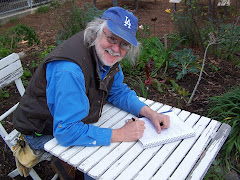
Lettuce is one of our winter crops in Los Angeles – Merville des Quatres Saissons (Marvel of the Four Seasons) is more like Marvel of the Two Seasons here – our summers are way too hot to grow this lovely French belle, but in cooler months this is a true delight that is as tasty as it is beautiful – and it's really beautiful!!
As the Summer crops begin to decline, we now get ready to see the seasons change in a dramatic fashion. The plants that have given you tomatoes all summer, are mostly a heap of sad, brown vines. If there has not been any difficult diseases, I prefer to leave the vegetation where it lays. I chop it up using my trusty pruners or a machete – or a shovel, if it is handy and will do the job. The cut up plant debris is left where it lies and fresh mulch is piled up on top of it – to three or four inches deep. The paths are filled with wood chips if I don't have a clover or other green manure crop growing there. The old vegetation will break down and in the process will become composted in place.
These plants have drawn nutrients from the soil and, by leaving them in place, we allow some of that nutritional value to be returned to the soil. It's true, when we harvest a tomato, we are really harvesting the soil's fertility that has been converted via the sun's energy into the things we eat to live. Putting the tomato plant back into the soil, without the tomatoes you harvested, represents a net loss for the soil. That's where the additional mulch and wood chips come in – we try to replace the stuff we ate with stuff that will allow the soil to recreate its bevy of nutrients to nourish our next round of food plants. It is not sufficient, in the long run, to just add fertilizers – we need to add things that will provide sustenance for the critters in the soil – a thriving soil ecology will provide better nutrition to your plants without spending needless dollars on fertilizer, most of which will only provide pollution of our ground water.
In a garden where perennial weeds are not a huge problem, I encourage everyone to plant a perennial crop that will assist in nourishing the soil. I like any one of several clovers or alfalfa or whatever else that will take mild foot traffic and will do something to add to the fertility of the soil. If this crop is mowed in a sustainable manner – like with a hand sickle, for a small area, to a scythe for larger areas – the mowings can be put right back into the beds next to where it was cut. Some kind of soil regeneration must be happening all the time or the soil will eventually not support food crops. Unfortunately, growing in a community garden, control of the perennial weeds is only as good as the worst gardener and so a perennial cover crop on the pathways isn't always a practice we can use.
One portion of the garden needs to be left fallow in every season, 'fallow' means it is not growing a crop to harvest – usually what we call a green manure crop. For gardeners in Sunset Zone 24, that means a part of the garden can be left without growing crops to harvest every single month of the year. In areas where there is not a huge problem with perennial weeds, the paths can supplement this soil enrichment by growing something like clover year round that improves soil viability. In any growing season, it is better to have the soil covered with some crop – even a crop of weeds is better than leaving the soil barren, except they'll produce more weeds if they go to seed.
More September later in the month!
david









.jpg)